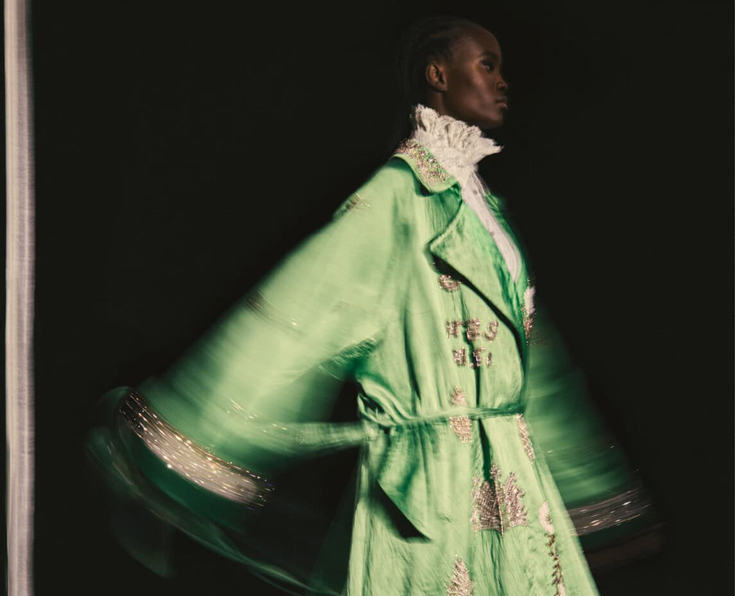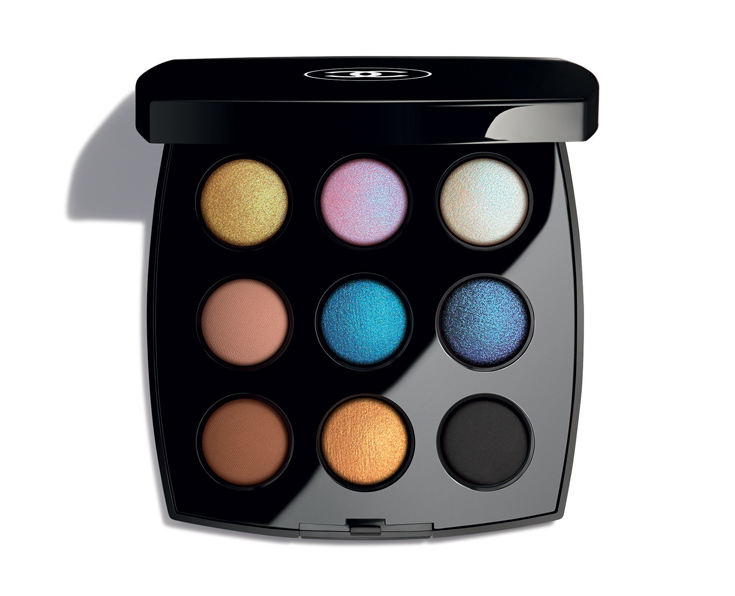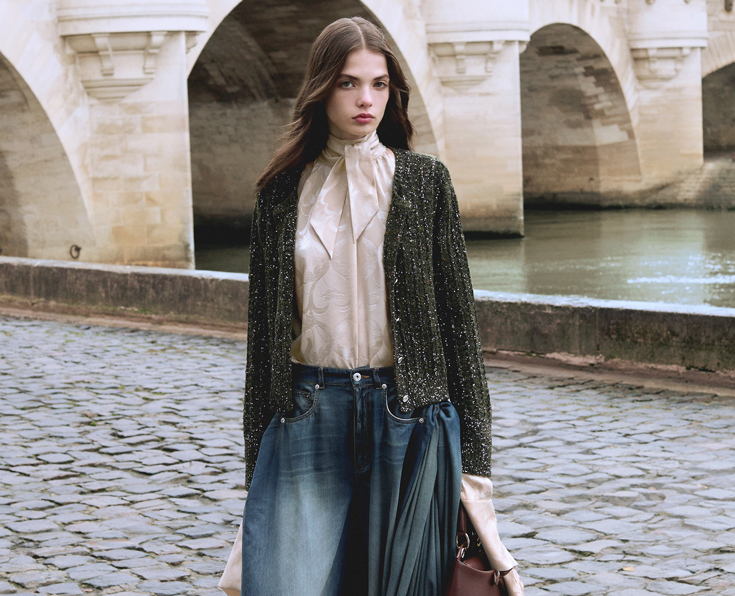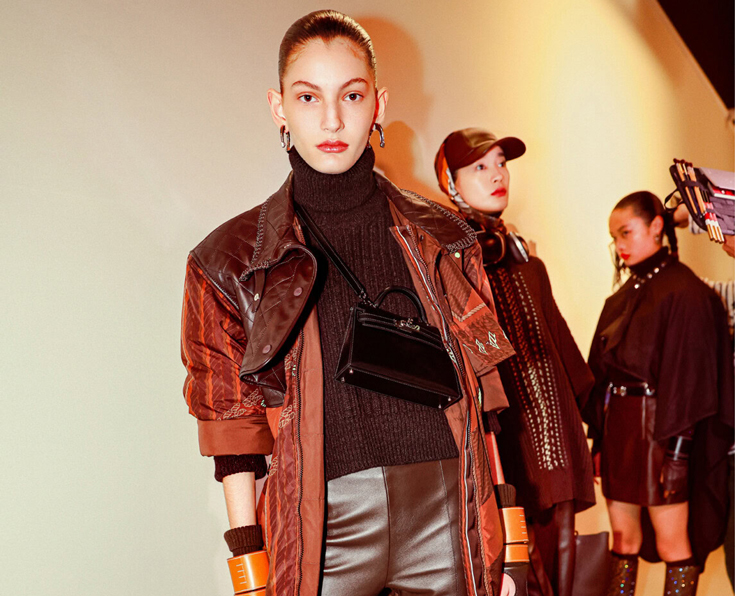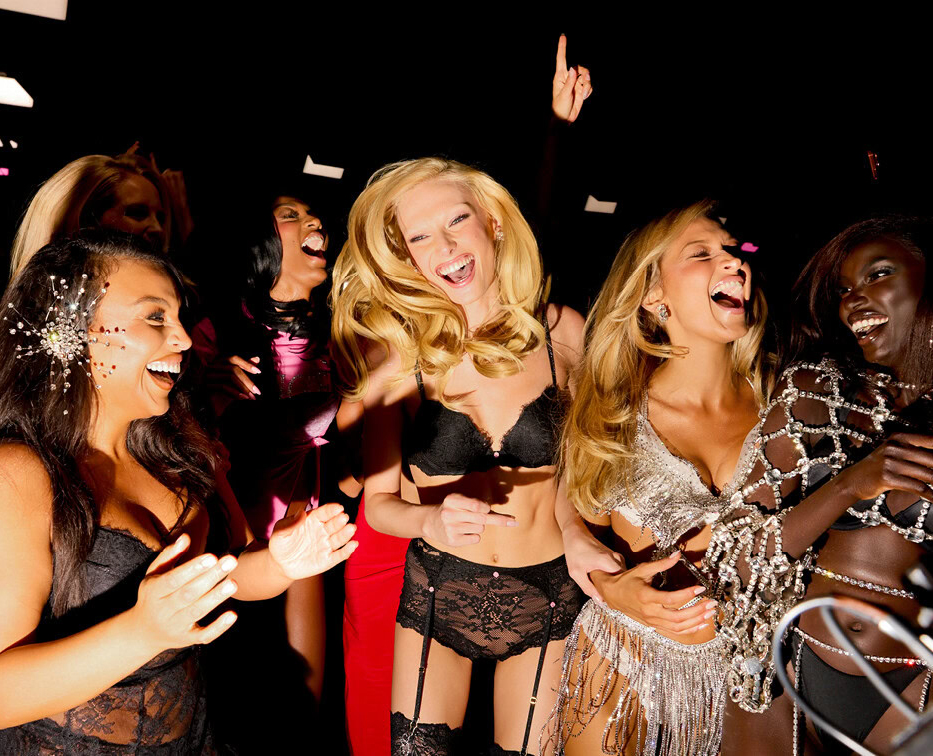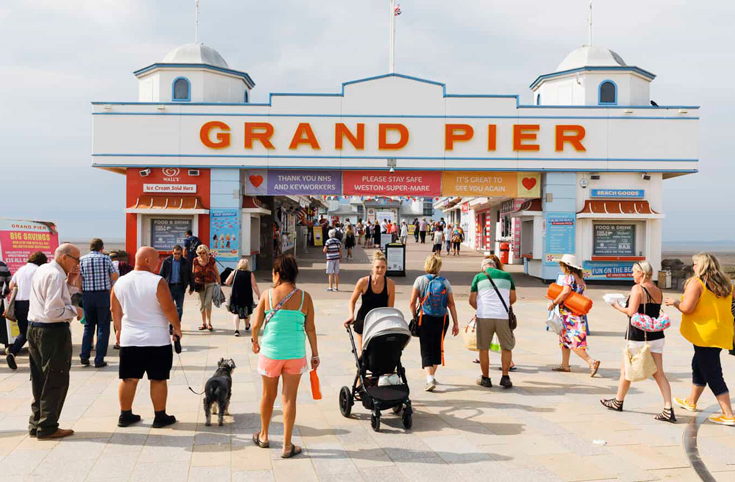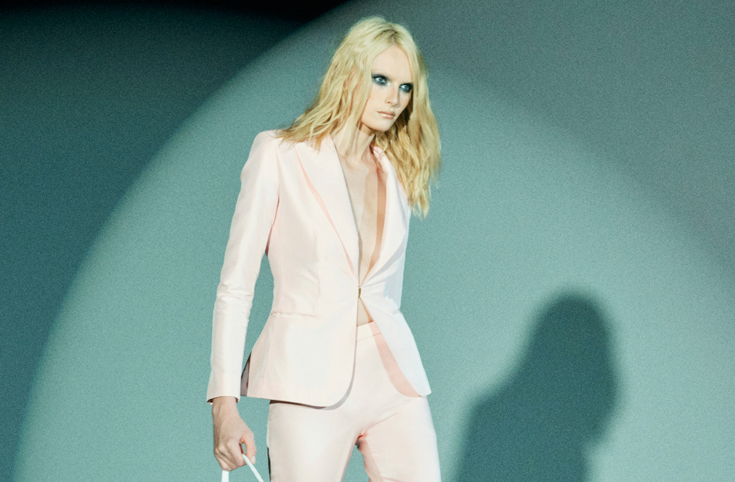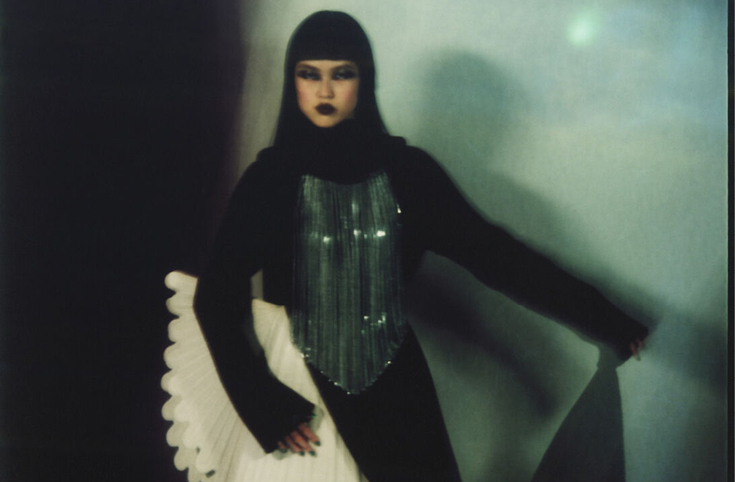HOW TOM FORD HEALED HIMSELF

His Gucci years defined the look of an era, but Tom Ford wasn’t done with shaping the zeitgeist when he left the brand in 2004. A new glossy tome, Tom Ford 002, celebrates the superstar designer’s post-Gucci life as he got sober, built his eponymous fashion and beauty brand, established himself as an award-winning movie director and became a father. In an exclusive extract, Ford sits down with the renowned fashion writer Bridget Foley, his book’s co-author, to talk about his creative Act II.
Bridget Foley: What was your mindset when you left Gucci Group?
Tom Ford: I was horribly depressed. I was angry. It took me ten years – ten years – to get over it.
BF: Was designing Gucci and Saint Laurent no longer fulfilling creatively?
TF: It was creative to the end. It wasn’t that designing wasn’t stimulating or fulfilling, but the number of collections and shuttling back and forth from London to Paris to Milan every two or three days – the weight of it was getting to me. I’ve often said that everything in my life is great, but there’s so much greatness that it can be horrible. I think this is true of many driven people who become successful. We often don’t stop to enjoy what we have because we’re always rushing to the next thing and the next thing and the next thing.
BF: How do you assess your impact during that remarkable fashion period of the mid-’90s through mid-aughts?
TF: I think that I played a large part in the rediscovery of a kind of late mid-twentieth-century hedonistic glamour, and I melded that with contemporary taste. I did this with the clothes and accessories in my first few hit collections at Gucci, and also with architecture and furniture design through my redesign of the Gucci stores and through my advertising campaigns.
BF: Your impact wasn’t just about your fashion. You and Domenico De Sole made the early acquisitions that turned Gucci from a single brand into Gucci Group, which became Kering after you left.
TF: Yes, we made numerous important acquisitions: Yves Saint Laurent, Alexander McQueen, Balenciaga, Bottega Veneta, Boucheron, Stella McCartney [no longer a part of Kering]. Others have been made since we left, but the big, initial acquisitions were done when we were there. So, we created Gucci Group. [Note: Ford joined Gucci in 1990. By 1996, it was a publicly-traded company run by De Sole and Ford. After a failed hostile takeover attempt in 1999 by luxury conglomerate LVMH, Ford and De Sole allied with François Pinault, who acquired a substantial stake in the company, providing Gucci with the cash to become Gucci Group. In 2003, Pinault’s Pinault-Printemps-Redoute purchased the remaining stake for 100 per cent of Gucci Group and Ford and De Sole exited soon thereafter. The group later became Kering and is now run by François-Henri Pinault.]
BF: The cultural memory is short.
TF: Fashion marches on. I often meet people who don’t even know I was at Gucci or Yves Saint Laurent. They just know my brand as Tom Ford. Some of them didn’t know me until the Jay-Z song [named after him, from the 2013 album Magna Carta Holy Grail]. Young customers were barely alive when I was at Gucci.
BF: Does Gucci’s 100th anniversary, in 2021, mean anything to you?
TF: This is the first I’m hearing about it. I’m more aware of [Lady] Gaga and Adam Driver playing Patrizia [Reggiani] and Maurizio [Gucci; he was shot dead by a hitman hired by Patrizia, his ex-wife] in the movie [House of Gucci].
BF: You said it took you ten years to get over your Gucci Group experience.
TF: Yes. I received the CFDA Lifetime Achievement Award in 2014. Obviously, I invited some people I worked with to the ceremony, those I’d worked with at Gucci. It never occurred to me to invite anyone who had only been with me at Tom Ford. Because in my head, Tom Ford had meant nothing, and my lifetime achievement was Gucci and Saint Laurent. People were very upset, which I didn’t hear until later. But I felt I had accomplished nothing on my own.
BF: Accomplished nothing? Let’s see, by that time, you had launched a global luxury brand, opened 126 stores, started an incredibly successful beauty and eyewear business, and made an Oscar-, Bafta- and Golden Globe-nominated film.
TF: True. Most important, Richard [Buckley, Ford’s husband, who died in September 2021] and I had a child [Jack, born in 2012]. But in my mind, the professional things didn’t register. It took ten years for me to feel good about myself, to detach from Gucci Group and actually move along.
BF: Was there a concrete turning point?
TF: Do you know what helped? It was when Alessandro Michele became creative director of Gucci [in 2015]. I love him, and I think what he’s done is brilliant. I hired him at Gucci. We correspond and send each other flowers; we have a very nice relationship. It sounds weird, that having somebody all of a sudden do a great job at your old job would make you feel better, but it did. Somehow, it helped me detach. Maybe because up until then there was a recycling ethos at Gucci, which I felt was based on my work there. It wasn’t like I was jealous of it. It was all subconscious, and it was a long time before I realised how long it took me to get over it. Throw in that I stopped drinking. So I had actually accomplished an enormous amount, but I didn’t feel that I had
BF: “Throw in” that you stopped drinking. That’s hardly an aside. Back to your exit, you and Domenico left Gucci Group after a conflict with the Pinaults. You were also frustrated with fashion in general, specifically, the relentless pace.
TF: I was just so burned out. I was physically and mentally exhausted from doing, at the end, 16 shows a year between Saint Laurent and Gucci; also being vice-chairman and creative director of Gucci Group and a key player on our Acquisitions Committee and being in all these business meetings, and meeting with shareholders. I was drinking and doing a lot of coke. Had it gone on, I would have been one of those stories of an overdose in the bathtub.
BF: Do you really think so?
TF: Sleeping pills, antidepressants and tranquilisers were a daily occurrence. Occasionally, Vicodin was thrown into the mix. Alcohol was a daily occurrence, big-time, all day long. Cocaine was a three- or four-days-a-week occurrence. Then I would come home and take four Excedrin and drink a giant litre of water to combat the headache and hangover the next day. I would get in a hot bathtub and often fall asleep. So, yes, I would have been one of those sad tales of fashion.

BF: We spoke for the first book, right after you left Gucci. You seemed completely lucid, and you had a plan.
TF: I was always a highly functional alcoholic. But it got worse after I left Gucci; it got much worse. Richard [then editor-in- chief of Vogue Hommes] stayed on in Paris. We were going to leave together, and kind of retire together. But he ended up staying on for another year, and I was pretty much alone and mostly in L.A.
BF: That was difficult?
TF: I was in Los Angeles alone more than I had originally planned because we were redoing a house in London. I was just so deeply depressed. That fuelled the drinking. That’s where I fell asleep in the tub all the time.
BF: Why did the drinking and drugs escalate after you left Gucci?
TF: It was going on during. It started escalating in about 2000. After I took over at YSL and we became Gucci Group, the pressure really ramped up. Several people in the office used to hide their drug use from me until they realised that it was something I didn’t mind. When you start in the morning doing a bit of coke, it’s becoming a problem. I mean, it’s a problem if you’re going out at night three times a week and doing coke. Coke was just a regular part of our life in London, but I don’t think Richard was aware of the coke until much later. I’d get up in the morning to work out. I’d say, “I’m really tired.” My personal trainer would say, “Did you go out last night?” I’d say, “Not really. I had three vodka tonics and a line of coke.” And he’d say, “Well, that’s not bad.”
BF: You lived in London while you were creative director of Gucci. The design studio was based there, correct?
TF: I moved the Gucci design studio from Florence to London in 1997. Domenico and our corporate office moved as well. We had a spectacular building on Grafton Street in Mayfair.
BF: And you found London conducive to overindulgence.
TF: I love London. It is in many ways my favourite city, but in certain circles, it can be very, very much about alcohol. You can easily have twelve drinks a day, and no one thinks you have a problem. Lunch, two drinks, totally normal. Five o’clock in the office, it’s cocktail time, another two drinks at least before you go home.
BF: You drank at work?
TF: Absolutely. Five o’clock, the cocktails came out – vodka tonics and Moscow mules. We worked until 8.30, and everyone drank two or three drinks. So we’re up to four or five. Then you go out to dinner, another two or three. Or, if I’m going to a fancy dinner, I’m getting dressed and there are two drinks while I’m getting dressed, while I’m taking a bath. So now we’re up to seven. At dinner, another two or three. Then I go out to a club, another two or three. So easily, you’re consuming ten to twelve drinks a day. When I stopped drinking, I had to remove myself from London. I had to remove myself from some of my friends. In some cases, we just drifted apart; they were friends because we were doing drugs and drinking. Others remain friends and still drink and they’re fine.
BF: Were you eating nothing? Because that is a lot to drink and not gain weight, which you never did.
TF: I was eating nothing. I was eating lettuce leaves. There was no way I was going to eat pasta. I ate nothing. I was weighing myself every day. As I still do.
BF: There must have been some out-of-control, embarrassing episodes.
TF: I usually spent my mornings writing notes and sending flowers for all the things I’d done. I did an interview with [former fashion editor of The Sunday Times] Colin McDowell and later he told me that I sounded crazy, that I wasn’t even making sense. [The at-large editor of BoF] Tim Blanks picked up on it too, and told Richard, “I think Tom has a coke problem.” I started hallucinating. I would wake up in the morning seeing ants crawling on the wall. And there were no ants.
BF: Was there a tipping point, a specific episode or just an overall recognition of your descent?
TF: It was a combination. I was in L.A., at a friend’s house for lunch. I was kicking back the drinks. People don’t do that in L.A.; they certainly don’t “day drink”. Another guest, also a friend, said to me, “Have you ever thought that maybe you have a drinking problem?” That was the first time anyone outside of fashion said that, although Richard had come to me and said, “I don’t know if you’re an alcoholic, but people are starting to talk about the fact that you have a drinking problem.”
BF: How did you stop?
TF: I did a lot of research, and I knew exactly what phase of alcoholism I was in. Certain things were happening; I was falling into a textbook phase of the process of serious alcoholism. I went to a couple of meetings. Those were not for me – the group things and the religious aspect. So I worked with a therapist for a year, two to three times a week, to help me stop drinking.
BF: You make it sound easy.
TF: No. It wasn’t easy at all. I had a few false starts where I would stop for a while and then I would have a drink, and that would be bad. Then I just wanted to quit drinking so badly because it was starting to ruin my life. I am an extremely pragmatic person. I read several books on alcoholism as part of the process of stopping. I educated myself, not only on the phases of alcoholism but on the fact that ethanol, which is in every single drink, is a poison that your body has to eliminate. That’s why you have a hangover and, of course, it’s your liver that’s detoxifying. It helped me to start to think of it in a technical way and to understand why I felt like I did and why it was bad – aside from its effect on my behaviour. A lot of it was driven by depression and escapism. I realised I wasn’t drinking to relax. I was drinking to escape.
BF: Once you stopped drinking, did you stop the drugs?
TF: Alcohol was the gateway. I would say to myself, “I am not doing that anymore.” Then I would go out and have three drinks, and, “Oh, come on, let’s just…” Alcohol was the gateway to everything else.
BF: This all started as your work responsibilities expanded?
TF: It probably had a lot to do with the pressure I was under in my business life. I think that pressure is one reason that alcohol and drugs consume so many people in the fashion industry – the demand to be creative according to a calendar. But I had a history of this. In high school in the ’70s, we drank, smoked pot, did a little coke. So it didn’t scare me. For me, coke was a relief: “Ohhh, life can be nice; ohhh, it’s actually great.” I’m what’s called in psychological terms “dysthymic,” which means that my general mood is a bit lower than a lot of people’s general moods. It’s not necessarily depression; it’s just a little bit lower. So I often felt that I needed coke to relax when I was working so hard.
BF: Do you mark your sobriety to a specific date?
TF: May 15th, 2009.
BF: Do you miss drinking?
TF: Never. It took me a while to feel comfortable, but I don’t miss drinking at all. And I can mix drinks and hand them to people. Now, I get bored after 11 o’clock at a party when everyone else has had more than two or three drinks. I’ll say, “Okay. I’m going home.” I still have the addictive personality: I cannot see a doughnut without eating it. And I don’t eat one, I eat six. Or eight or ten. But I have no desire to have a drink. None.
BF: When did you realise you felt comfortable with your sobriety?
TF: I guess it was mostly around the dinner table, when I could make people laugh again.
BF: How have you, or will you, talk to Jack about drinking and drugs?
TF: I haven’t spoken with him about this yet, but of course, I will. There is, perhaps, a genetic aspect to it. My father basically died from alcoholism, although he managed to make it to 88. So that is a factor, and then it can be a personality factor. There are people with addictive personalities and those without. And of course a situational factor – if one is living with a great deal of stress or going through a sad period in their life – can exacerbate these tendencies. Normalisation of substance abuse in one’s life by one’s environment or peer group can also delay the realisation that one has a problem. Managing stress in my life was a key factor for me in being able to stop drinking.
BF: All of this was going on as you were plotting out your post- Gucci professional life. You obviously weren’t in full control, but you always presented that way in interviews and at events, a paragon of self-assurance.
TF: I don’t want to say that’s an act because it comes from me, and so it’s who I am. But it is a performance. I am a complete introvert. I get my strength from being alone. It’s a performance for me to dress, go out, da da da. It’s exhausting. It wears on me.
BF: Even though it wears on you, do you enjoy the act of performance on some level?
TF: I know how to perform. I’m good at it, but it still took a year of pandemic Zooms for me to get over having to put my ring light behind the screen, and to realise everybody looks horrible on Zoom. It’s okay; I look like hell.
BF: You certainly don’t look like hell.
TF: I’ve mellowed. I really have. But if I have to go to an event, I still don’t feel good unless I go through the whole process. I put on a jacket, and I’m playing the part of a successful, confident fashion designer. It’s a part. A part that comes from me, but it’s a part.
BF: You left Gucci Group feeling that your life was in an alcohol-fuelled downward spiral, yet you had a very lucid plan for the future.
TF: There was another side. That side of me felt great relief that the whole Gucci thing ended after 10 years. It was a combination of relief and feeling that I’d escaped pretty much unscathed critically. A couple of collections got ripped apart, but most of the Gucci and Saint Laurent collections were strong, and the sales were going up and up and up and up and up. So I kind of felt like, “Whew! I made it out.” I’d made it out physically, and critically, feeling proud of what I’d done. But “I am never doing that again!” is how I felt.
BF: Your resolve to leave fashion was driven by psychological and emotional exhaustion, exacerbated by substance abuse. Was it driven in parallel by your desire to direct films?
TF: It wasn’t in parallel, but I knew what I wanted to do. I had hatched that plan long before, when we bought our house in L.A., in ’96 or ’97. I thought that my goal of directing films wouldn’t seem as preposterous to people if I’d talked about it early on and already moved in that world a bit. As it turned out, it still did seem preposterous to people.
BF: Why did it seem preposterous to people?
TF: I don’t know! I never understood why people thought I couldn’t make films. Whenever I set out to do something, it’s so clear in my head that what’s shocking to me isn’t that I manage to pull it off, but that other people didn’t see that I could pull it off. That sounds egotistical, but it’s how I am.
BF: You thought you were finished with fashion. Yet you returned to the industry rather quickly, through beauty and eyewear. What brought you back?
TF: I read every script in town and didn’t find one I loved. I realised how slowly the movie industry worked. I started to become bored and insecure. I realised that I had built great value in my name, but that in a few years, no one would remember it. I decided that if I were ever going to return to any part of the fashion industry that I needed to anchor my name in the mind of the consumer.
BF: And now, well into the second decade of your professional phase two, you are a multi-hyphenate beauty mogul/fashion designer/film director. Is it as you expected?
TF: Yes and no. Even with all of the advantages that I had – and I had many – starting a new luxury business in today’s world is extremely difficult. More difficult than I could have imagined. And then, in some ways, it is exactly as I expected. Except that as one gets older time moves more quickly, and I can’t believe that it has been 15 years.
Top image by Jeff Burton. ‘Tom Ford 002’ by Tom Ford is out now. Purchase here.

